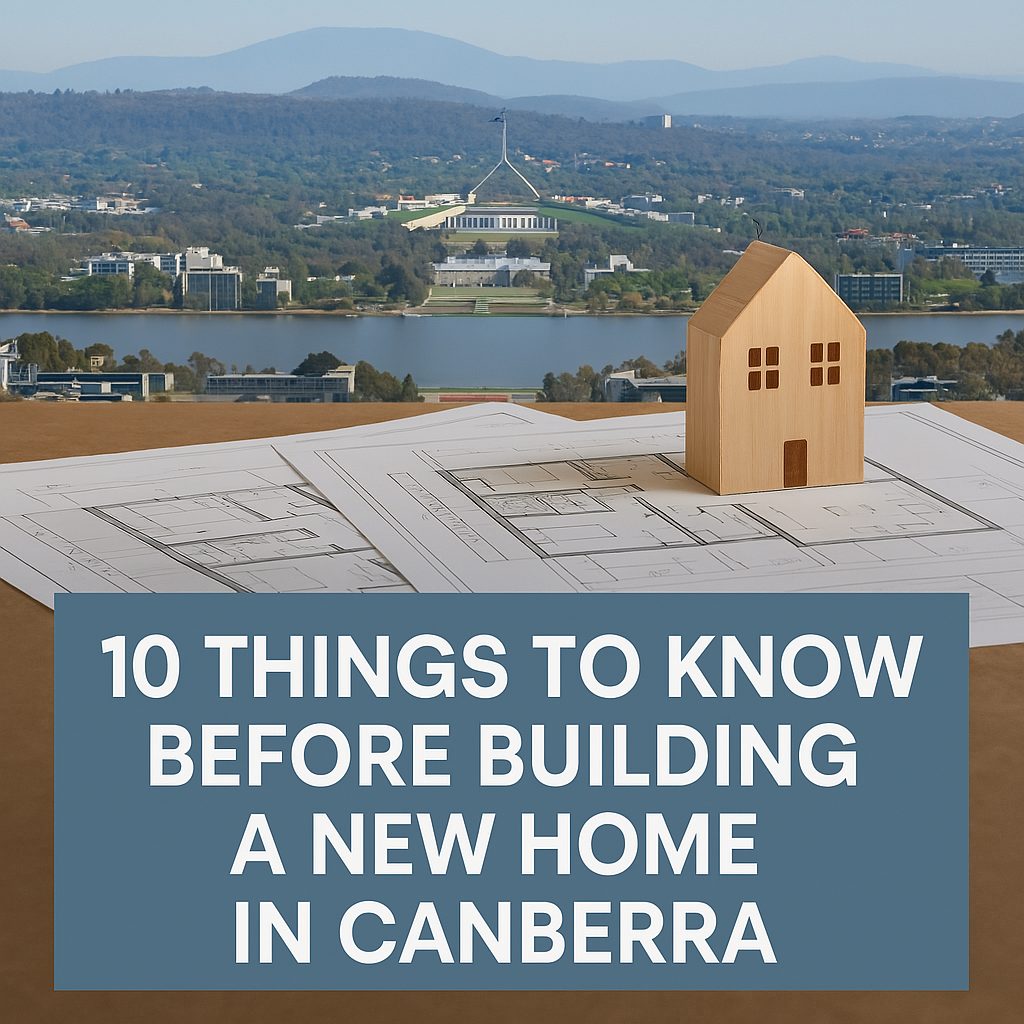
-
Understanding building codes in Canberra is important for a smooth construction process.
-
Good planning and budgeting are key to avoiding unexpected costs.
-
Picking the right location and plot greatly affects your lifestyle and property value.
-
Using sustainable building practices can improve your home’s comfort and lower its environmental impact.
-
Working with trusted builders and contractors is important for a successful project.
Introduction
Building a new home in Canberra is a thrilling task. But, it needs careful planning and thought. Before you start, you should know the building codes and rules in the Australian Capital Territory. Check your financial situation too. It’s important to find trusted builders. This guide will help you understand what matters before you start your home construction in Canberra. This way, you can enjoy a smooth and rewarding experience.
Understanding the Basics of Home Building in Canberra
Building a new home is a big investment. It can impact your money and your feelings. In Canberra, several things can change this process. The unique style of the city and its building regulations matter. Working with experts, like architects, builders, and interior designers, can help you build your home more easily.
Canberra places a strong emphasis on green building practices. Knowing about these can help you build a more eco-friendly home and save money in the long run.
Key Considerations Before Starting Your Project
Before you start building, it’s really important to understand the building rules in Canberra. These rules cover things like energy efficiency, safety of the structure, and fire safety. Make sure your architect and builder are familiar with these regulations. Doing this can help you avoid costly changes and delays in the future.
Choosing the right plot of land is very important. You should think about how close it is to schools, parks, and public transport. Also, consider the amount of natural light and the views you can enjoy. These things can really change your living experience.
Focus on being kind to the environment. Using energy-saving things like solar panels and rainwater systems can help cut down your carbon footprint. It can also save you money on energy bills in the long run.
Common Mistakes to Avoid as a First-Time Home Builder
One major mistake first-time home builders make is not fully understanding costs. You should think about the costs of building and additional expenses like permits, inspections, and landscaping. It’s smart to have a backup fund that is at least 10% of your total budget. This way, you can manage any unexpected costs.
Another common mistake is not checking and comparing quotes from various builders and contractors. Getting several quotes can help you find a good deal. Just keep in mind that the cheapest option is not always the best one. You should consider the builder’s reputation, their experience, and the quality of construction materials they use.
It’s important to speak openly with your financial institutions about your project timeline and budget. Keeping them informed and addressing any issues quickly can help avoid financial problems during the construction process.
What You Need to Get Started
 When you start to build your new home, it’s important to get the right tools and find a good team. First, think about what you want in your home. Consider how you live, the number of people in your family, and the style you prefer. A skilled architect can help you create practical architectural plans from your ideas.
When you start to build your new home, it’s important to get the right tools and find a good team. First, think about what you want in your home. Consider how you live, the number of people in your family, and the style you prefer. A skilled architect can help you create practical architectural plans from your ideas.
Do your homework. Choose a group of skilled workers. This group should have a licensed builder, reliable subcontractors, and an experienced surveyor. They will be essential for making your project successful.
Essential Equipment and Resources for Home Building
Before construction begins, it is important to have clear building plans. An architect usually creates these plans. They act as a visual guide for the entire construction process. The plans display the layout, sizes, and materials needed.
While the details of equipment may vary based on the project’s size and difficulty, there are some basic tools that you always need. These are:
-
Heavy machinery: Machines like excavators, loaders, and concrete mixers are important for prepping the site, building the foundation, and moving materials.
-
Hand tools: A solid collection of hand tools, including hammers, saws, drills, and levels, is needed for various construction tasks.
-
Safety gear: To ensure everyone’s safety, provide your team with essential gear like hard hats, safety glasses, gloves, and bright vests.
Choosing the right construction companies in Canberra can be tough. Look for companies that have a good track record. Check their client reviews and make sure they focus on using quality materials. This will help you feel more confident.
Securing Building Permits and Legal Requirements in Canberra
Building a new home in Canberra needs to follow strict building codes set by local authorities. You must get the proper permits before beginning your project. These permits ensure that your home is safe, follows environmental guidelines, and meets zoning laws.
The building codes in Canberra cover important topics like structural strength, fire safety, energy efficiency, and access for everyone. It’s a good idea to learn these codes or discuss them with your builder. Doing this can help you avoid issues during inspections.
Also, you should know the legal steps to get your new home connected to important services like electricity, water, gas, and sewage. By working with your builder and the service providers, you can make this connection process easier.
Step-by-Step Guide to Building Your New Home
 Building a new home involves several steps. Each step flows into the next one. First, you should choose a good location. Then, it’s important to plan carefully. Doing this will make the entire home building process smoother and your experience will be better.
Building a new home involves several steps. Each step flows into the next one. First, you should choose a good location. Then, it’s important to plan carefully. Doing this will make the entire home building process smoother and your experience will be better.
This easy guide will assist you in the key steps to build your dream home.
Step 1: Choosing the Right Location and Plot
Choosing the right place is very important for your life in your new Canberra home. Think about how long it takes to get to work or school each day. Look at how close schools, parks, and medical facilities are. Also, check the distance to shopping areas. You should consider how the neighborhood feels, if it’s noisy, and how easy it is to use public transport.
The details of the plot of land matter a lot. The size, shape, slope, and type of soil can change how you design and build your home. It is smart to hire a surveyor to look at the land first. They can discover any issues or opportunities that it might have.
Don’t overlook the environmental impact of your chosen spot. Check how much natural light you receive, the wind direction, and the plants nearby. These factors can improve energy efficiency, ventilation, and comfort. Choosing a location that aligns with sustainable design ideas can help you build a home that is good for the environment and also saves you money.
Step 2: Designing Your Home Layout
Creating a good floor plan is important for making a home that meets your lifestyle and needs. Consider your family size and how you enjoy entertaining. Organize the space so that rooms connect well with each other, focusing on natural light and openness.
Also, consider your need for storage and privacy, as well as where you put windows. This can help you let in more natural light and save energy. Work closely with your architect. They can help you create a floor plan that uses your living space wisely and fits your budget.
Think about adding eco-friendly features like passive heating and cooling, rainwater collection systems, and energy-saving appliances. These choices can make your home feel comfortable, help the environment, and save you money.
Step 3: Laying the Foundation
Building a strong and durable foundation is crucial for the stability of your new home. The type of foundation you require will depend on several factors. These include the type of soil, the weight of the building, and how steep the land is.
Choosing the right construction materials for your foundation is very important for its strength and durability. The details matter. The type of concrete, the steel reinforcement, and the waterproofing all play a role in making your home’s foundation stronger and last longer.
You can talk to your builder about these details. Ask them questions about the materials and methods they will use. Learning about this will give you a strong foundation for your new home. It will also give you peace of mind for many years.
Step 4: Constructing the Framework
Once the foundation is done, the next part of building your home starts. This stage involves putting up the framework. It includes framing the walls, floors, and roof. Builders usually use materials like timber or steel. The choice of material will depend on what you like, local building codes, and your budget.
It’s a good idea to get expert advice from structural engineers. They help check that your building’s structure is stable and safe. A strong framework is key for holding the weight of the roof, walls, and other parts of your home. This support helps your home last longer.
Hire building companies that are well-known for their experience, skills, and quality work. It’s important to communicate clearly with your builder during this time. This will help ensure that your vision turns into a reality.
Step 5: Installing Roofing and Exteriors
The installation of the roof is an important step in building your home. When choosing roofing materials, think about how they look, how long they last, your budget, and the weather where you live. Some popular roofing choices in Canberra include:
|
Material |
Pros |
Cons |
|---|---|---|
|
Concrete tiles |
Durable, fire-resistant, good thermal insulation |
Heavy, requires a strong roof structure |
|
Metal roofing |
Lightweight, durable, energy-efficient |
Can be noisy during rain |
|
Clay tiles |
Aesthetically versatile, long-lasting, energy-efficient |
More expensive than concrete tiles |
At the same time, the outer walls are covered with selected finishes. When picking exterior finishes, it’s important to think about labour costs and how complex the installation is. Popular choices include brick veneer, rendered finishes, weatherboards, and cladding systems.
Conclusion
In conclusion, building a new home in Canberra needs careful planning and focus. If you understand the basics, avoid mistakes, and follow a clear guide, your project can be successful. Don’t forget to consider location, design, foundation, framework, roofing, and exteriors. It is crucial to get building permits and meet legal requirements for a smooth process. Being prepared and having the right resources will support you during your home-building journey. For more tips and advice, visit our frequently asked questions section or seek professional help. Happy building!
Frequently Asked Questions
What is the Average Cost of Building a New Home in Canberra?
Building costs in Canberra can vary. This is influenced by the house size, quality of materials, and labour costs. On average, you can expect to spend between $2,500 and $4,000 for each square meter. It is important to speak with builders who are registered with the national home builders registration council. Also, consult financial institutions to get a better estimate based on your needs and financial situation.
